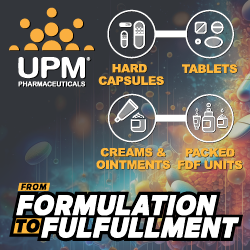Issue:January/February 2025
MICRONEEDLE MANUFACTURING - The Value of a Manufacturing-Oriented Microneedle Mindset
 INTRODUCTION
INTRODUCTION
Microneedle array patches (MAPs) are at the forefront of drug delivery innovation, with the potential to revolutionize how medications and vaccines are administered. These patches offer the potential to combine the ease of transdermal application with the efficacy of injections, providing a more intuitive method of drug delivery for a wide range of therapeutics.1
However, despite the significant buzz surrounding microneedle technology, a considerable gap remains between innovations and market-ready products. While early stage development and preclinical studies have shown promising results, the challenge of translating these advancements into scalable, commercially viable products persists.
To bridge this gap, a shift in mindset is crucial. From the start of the process, researchers, biotech companies, and manufacturers can benefit from adopting a commercialization-focused approach. This means considering not just the initial innovation but also how that technology will translate to GMP clinical production and eventual commercial-scale manufacturing. Thinking ahead is essential for minimizing risk and attracting the investment needed to bring microneedle array patch products through late-stage clinical trials and to market.
 THE CURRENT STATE OF MICRONEEDLE TECHNOLOGY
THE CURRENT STATE OF MICRONEEDLE TECHNOLOGY
Recent years have seen a diversification of microneedle types, opening possibilities for addressing a broader range of therapeutic applications and patient needs. Based on data from www.clinicaltrials.gov, these platforms have been studied for a variety of indications, including vaccines, topical anesthesia, skin disorders, cystic fibrosis, oral diseases, diabetes, osteoporosis, CNS, and more.2
Importantly, the field has witnessed a significant shift from conceptual development to clinical trials. An increasing number of companies are advancing their microneedle technologies into preclinical and early clinical stages, generating valuable data on efficacy, safety, and patient acceptability. This progression is crucial for validating the technology and paving the way for broader adoption.
The potential of microneedle technology has not gone unnoticed by funding bodies and government entities, which have made substantial investments in the space in recent years. These investments are catalyzing advancements through various stages of clinical development, reflecting growing recognition of the technology’s potential to address global health challenges. Possibilities include bringing vaccines to more remote areas, increasing national stockpiles to bolster preparedness for future pandemics, and improving the ease of vaccine administration.
 WHY MICRONEEDLES & WHY NOW?
WHY MICRONEEDLES & WHY NOW?
MAPs represent a significant leap forward in patient-centric drug delivery. The benefits from a patient perspective are clear and compelling. Microneedle patches offer a simple, intuitive application process that could potentially be done at home, possibly eliminating the need for healthcare provider administration. This potential for self-application not only increases convenience but could also address the issue of needle phobia.1 Patient preference surrounding administration is driving design decisions in the industry, with developers focusing on creating patches that are not only effective, but also user-friendly and minimally invasive. The potential for at-home administration also opens new possibilities for improving medication adherence and reducing the burden on healthcare systems.
From a clinical standpoint, intradermal delivery via microneedle patches offers several advantages. The rapid onset of action due to quick absorption into the bloodstream makes this method particularly attractive for certain therapeutics in which speed is crucial.3 For vaccines, delivery to the dermis, rich in antigen-presenting cells, could potentially enhance efficacy and even allow for dose-sparing strategies.4
Perhaps one of the most transformative aspects of MAP technology is the potential for room temperature stability.5 This characteristic could revolutionize the supply chain for many therapeutics, particularly vaccines. The ability to transport and store these products without stringent cold chain requirements addresses one of the most significant challenges in global health: the “last mile” problem in vaccine distribution.
This not only improves access, but also has significant environmental and economic benefits, reducing the carbon footprint and costs associated with maintaining cold chains.
 ADDRESSING KEY CHALLENGES IN MICRONEEDLE MANUFACTURING
ADDRESSING KEY CHALLENGES IN MICRONEEDLE MANUFACTURING
The benefits of microneedles are evident and as the field progresses, it’s becoming increasingly clear that the next critical step is not just further innovation, but the ability to manufacture these designs at scale to take advantage of the potential for broad-reaching positive effects. Companies entering clinical development now face the challenge of navigating GMP clinical manufacturing and planning for eventual commercial production. An ability to navigate challenges in manufacturing is emerging as a key differentiator in bringing microneedle products to market.
COMPLEXITY ACROSS MANUFACTURING STAGES
The manufacturing process for microneedles is inherently complex, involving multiple steps that each require precise control:
Material Selection: The choice of materials for microneedle fabrication is critical, as it affects not only the mechanical properties of the needles but also their biocompatibility and drug release characteristics.
Microneedle Fabrication: This typically involves micro-molding processes that require high precision to consistently produce needles with the desired geometry and sharpness.
Drug Formulation: The drug must be formulated in a way that is compatible with the microneedle material and allows for efficient loading and release.
Drug Loading: Depending on the microneedle type, this could involve coating processes, incorporation into dissolving materials, or loading into hollow needles.
Patch Assembly: The microneedles must be integrated with a backing layer and potentially other components to form the final patch.
Packaging: The packaging must protect the delicate microneedle structures and maintain product stability.
Each of these steps presents its own set of challenges when scaling up to commercial production. For instance, maintaining consistent needle geometry and drug loading across large batches requires highly controlled processes and sophisticated quality control measures.
Moreover, the interdependence of these steps adds another layer of complexity. Changes in one part of the process can have ripple effects throughout the entire manufacturing chain. This underscores the importance of considering manufacturability from the earliest stages of product design.
OVERCOMING DOSAGE LIMITATIONS
One of the primary challenges facing MAP technology is the limitation on the amount of drug that can be delivered in a single application. This constraint has historically restricted the scope of suitable drug candidates primarily to very potent substances, such as hormones and vaccines. However, recent research has made significant strides in optimizing delivery to overcome this hurdle.
Optimizing MAPs for delivering larger doses consistently requires careful consideration of several critical elements:
Needle Height: The height of the microneedles is a key factor in determining penetration depth and drug payload capacity;1 while taller needles can potentially carry more medication, this must be weighed against user comfort and the risk of encountering pain receptors or blood vessels.
Microneedle Density: Increasing the quantity of microneedles on a single array can allow for a higher total dose delivery; however, this must be balanced with manufacturing feasibility and the potential for reduced penetration effectiveness due to force distribution across too many points, known as the “bed of nails” phenomenon.
Patch Dimensions & Layout: The overall size of the patch and the spacing between individual microneedles can impact both the total drug capacity and the uniformity of delivery; while larger patches can accommodate more needles or taller needles, they may be less user-friendly.6,7
Advanced coating techniques and formulation strategies are also being developed to maximize drug loading while ensuring rapid dissolution upon application.
Another crucial element for coated MAPs is the fine-tuning of droplet dimensions and placement on the microneedles. While larger droplets have the potential to carry larger drug doses, they may compromise the microneedle’s skin penetration efficacy. Research has shown that smaller droplets situated near the microneedle tips tend to achieve higher delivery efficiency, as they are more likely to be completely inserted into the dermis. The specific location of the droplet on the microneedle can also impact both the speed of drug release and the skin depth at which the medication is administered.
These advancements are crucial for the path to commercialization. As the technology demonstrates the ability to deliver larger doses consistently, it expands possibilities for a wider range of therapeutics. This makes MAPs more attractive for pharmaceutical companies considering investment in this delivery method, potentially accelerating the journey from lab to market.
BRIDGING THE GAP FROM LAB TO MARKET
As MAP technology progresses from early-stage development to clinical trials, the importance of GMP manufacturing capabilities becomes paramount. The ability to produce microneedle patches consistently at scale, while adhering to stringent quality standards, is as critical as the initial innovation itself.
Strategies for scaling up production involve careful consideration of material selection, manufacturing processes, and quality control measures. Injection molding has emerged as a preferred method for large-scale production of microneedle arrays due to its ability to produce complex geometries with high repeatability.8 However, achieving consistent microneedle production at scale requires careful optimization of molding parameters and tooling.
Addressing regulatory considerations early in the development process is crucial. While specific guidelines for MAP products are still evolving, developers must anticipate requirements for sterility, bioburden control, and product stability. Early engagement with regulatory bodies and participation in industry working groups can help shape a clear path to approval.
COLLABORATION IN THE MICRONEEDLE SPACE
The complex nature of MAP development necessitates a collaborative approach. Partnerships between innovative biotech companies, academic institutions, and experienced manufacturers are becoming increasingly common and valuable. These collaborations bring together cutting-edge research with practical manufacturing expertise, accelerating the path to commercialization.
CDMOs are playing a crucial role in filling the manufacturing gap. With their expertise in GMP production and scale-up strategies, CDMOs are helping earlystage companies navigate the challenging transition to clinical, and eventually commercial, manufacturing. This support is critical for minimizing risks associated with the technology and attracting the investment needed for late-stage clinical trials.
Industry-wide collaboration and knowledge sharing are also gaining momentum. Working groups involving developers, manufacturers, and regulatory consultants are collaborating to establish best practices and address common challenges. This collective approach is helping to advance the field as a whole, creating a more robust ecosystem for microneedle patch development and commercialization.
TOWARD A HOLISTIC, FORWARD-THINKING APPROACH
Successful commercialization of MAP technology requires a holistic, IND-enabling mindset from the earliest stages of development. This approach integrates end-user needs, manufacturing scalability, and regulatory considerations into the initial design process, rather than addressing these factors as afterthoughts.
Integrating end-user needs into early-stage design ensures that the final product will meet real-world requirements. This includes considerations such as ease of application, patient comfort, and compatibility with various therapeutic agents. By prioritizing these factors from the start, developers can create MAPs that are not only technically impressive but also practically viable in clinical settings.
Considering manufacturing scalability from the outset is crucial for smooth progression through clinical trials and eventual commercialization. This involves selecting materials and designs that are amenable to large-scale production, and developing processes that can be reliably scaled up while maintaining product quality and consistency. Early collaboration with manufacturing experts can provide valuable insights into potential challenges and solutions.
Adopting this holistic strategy can significantly accelerate the path to market-ready products. It allows for more streamlined progression through clinical trials, smoother scaling of manufacturing processes, and more efficient navigation of regulatory pathways. By anticipating and planning for these challenges, companies can potentially bring their MAP products to market faster and with greater success.
REFERENCES
- Avcil, M., and Çelik, A. Microneedles in Drug Delivery: Progress and Challenges. Micromachines (Basel). 2021;12(11):1321. doi:10.3390/mi12111321.
- ClinicalTrials.gov. Accessed May 17, 2023. www.clinicaltrials.gov.
- Jung, J.H., and Jin, S.G. Microneedle for transdermal drug delivery: current trends and fabrication. J Pharm Investig. 2021;51(5):503-517. doi:10.1007/s40005-021-00512-4.
- Ameri, M., Lewis, H., and Nguyen, J. Immunogenicity and safety of inactivated Influenza Split-Virion vaccine administered via a transdermal micro needle system. J Vaccines Immunol 2021;7.1, 41-48. doi:10.17352/jvi.000046.
- Kim, Y.C., Park, J.H., and Prausnitz, M.R. Microneedles for drug and vaccine delivery. Adv Drug Deliv Rev. 2012;64(14):1547-1568. doi:10.1016/j.addr.2012.04.005.
- Waghule, T., Singhvi, G., Dubey, S.K., et al. Microneedles: A smart approach and increasing potential for transdermal drug delivery system. Biomed Pharmacother. 2019;109:1249-1258. doi:10.1016/j.biopha.2018.10.078.
- Loizidou, E.Z., Inoue, N.T., Ashton-Barnett, J., et al. Evaluation of geometrical effects of microneedles on skin penetration by CT scan and finite element analysis. Eur J Pharm Biopharm. 2016;107:1-6. doi:10.1016/j.ejpb.2016.06.023.
- Mizuno, Y., Takasawa, K., Hanada, T., et al. Fabrication of novel-shaped microneedles to overcome the disadvantages of solid microneedles for the transdermal delivery of insulin. Biomed Microdevices. 2021;23(3):38. doi:10.1007/s10544-021-00576-x.

Andrew Riso serves as the Vice President, Dermal Delivery and Licensing at Kindeva Drug Delivery, where he leverages over 10 years of expertise in strategic planning, financing, market research, and commercial analysis within the biotech and drug delivery industries.
Total Page Views: 5963












